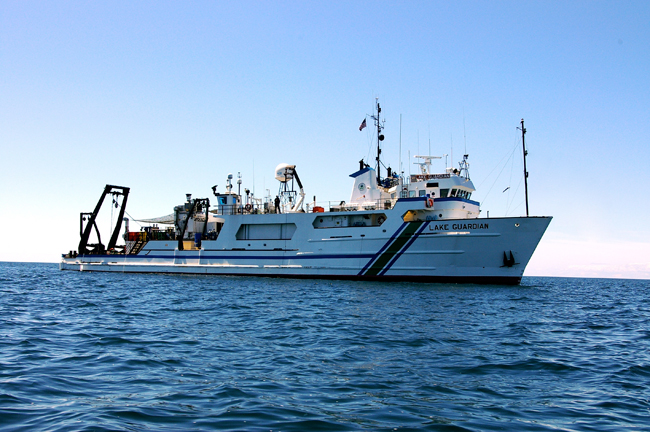
The federal (Environmental Protection Agency) research vessel R/V Lake Guardian on a CSMI tour on the Great Lakes. Credit: Michael Milligan and the Great Lakes Research Consortium.
Contact:
Stacy Furgal, Great Lakes Fisheries and Ecosystem Health Specialist, New York Sea Grant, E: slf85@cornell.edu, P: (315) 312-3042
New York Sea Grant facilitates the prioritized planning of CSMI research on the Great Lakes to add to the critical understanding of the world’s most complex freshwater system.
Oswego, NY, August 10, 2022 - In 2002, the U.S. and Canada began a program aimed at promoting, unifying, and organizing integrated research and long-term monitoring efforts in the Great Lakes. The program, known as the Cooperative Science and Monitoring Initiative (CSMI), cycles through the lakes on a 5-year rotation. New York Sea Grant (NYSG) is involved with the planning that occurs prior to the tours on Lake Ontario. This planning effort engages scientists, lake managers, and a broad group of public stakeholders to guide the concentrated design of research and projects to learn about the Great Lakes’ ecosystem, its fisheries, the food web, water quality, invasive species, and the unique contributions of each lake to the health of the system that is the largest freshwater system in the world.
In June of 2021, NYSG, alongside partners from Cornell University, cohosted a virtual workshop to collect input from partners and stakeholders to identify the science priorities for the 2023 CSMI field year on Lake Ontario. Over the course of the 2-day workshop, more than 130 participants from the U.S. and Canada provided their expertise and experiences to this critical information gathering. The conclusions from the workshop were published in a report co-authored by NYSG and Cornell University. In New York State, CSMI results are applied to update the Lakewide Action and Management Plan for Lake Ontario.
The Lake Ontario Cooperative Science and Monitoring Initiative 2023 Science Priority Planning Report and NYSG-developed fact sheets and videos about the CSMI on Lake Ontario are online at www.nyseagrant.org/csmi.
Project Partner:
• Cornell University
“Lake Ontario is a constantly changing ecosystem. We have to get a comprehensive understanding of what’s happening in the lake and what the response is to the various management actions that we’re taking by the governments on both the U.S. and the Canadian side of Lake Ontario. New York Sea Grant and others are playing a vital role in translating the information to helping the public understanding.” — Donald Zelazny, Great Lakes Programs Coordinator, New York State Department of Environmental Conservation
More Info: New York Sea Grant
New York Sea Grant (NYSG), a cooperative program of Cornell University
and the State University of New York (SUNY), is one of 34 university-based
programs under the National Oceanic and Atmospheric Administration’s
National Sea Grant College Program.
Since 1971, NYSG has represented a statewide network of integrated
research, education and extension services promoting coastal community
economic vitality, environmental sustainability and citizen awareness
and understanding about the State’s marine and Great Lakes resources.
Through NYSG’s efforts, the combined talents of university scientists
and extension specialists help develop and transfer science-based
information to many coastal user groups—businesses and industries,
federal, state and local government decision-makers and agency managers,
educators, the media and the interested public.
The program maintains Great Lakes offices at Cornell University, SUNY
Buffalo, SUNY Oswego and the Wayne County Cooperative Extension office
in Newark. In the State's marine waters, NYSG has offices at Stony Brook
University in Long Island, Brooklyn College and Cornell Cooperative
Extension in NYC and Kingston in the Hudson Valley.
For updates on Sea Grant activities: www.nyseagrant.org has RSS, Facebook, Twitter, Instagram, and YouTube links. NYSG offers a free e-list sign up via www.nyseagrant.org/nycoastlines for its flagship publication, NY Coastlines/Currents, which is published quarterly.